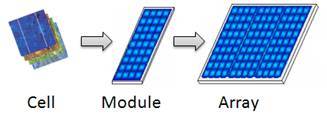When most of us think about how solar power works, one of the first things that comes to mind are solar panels.
On this page we’ll discuss what makes up a typical panel and the different types that are available.

It all starts with a solar cell. Cells are interconnected (usually in series) to form a module. Modules typically contain 60 solar cells. Panels are then constructed by connecting multiple modules. The final product that you’ll see on rooftops are a series of connected panels called an array.
There are five different components that make up a solar panel. The first, and serving as the protective layer, is typically tempered glass. Next is an anti-reflective sheet, then the solar cell. A thin polymer sheet then makes up the rear surface. Finally, a frame is required to hold it all together.
Types of photovoltaic technology
1.  Monocrystalline.
Monocrystalline.
Otherwise known as Single Crystal, this is the original photovoltaic technology. Like the name implies, this crystal is cut from a single, continuous solid cylinder of crystal. The cylinder is then sliced into thin wafers to create solar cells. This PV technology has been more efficient, yet more expensive to produce.
2.  Polycrystalline.
Polycrystalline.
This silicon material is melted and poured into a mold. After the mold cools, the slabs of silicon are cut into bricks, then once more into square wafers. This process creates less waste than with Monocrystalline tech. It is also less expensive, however it is not quite as efficient. This is due to energy that is lost at grain boundaries between different crystal grains.
3.Thin Film Photovoltaics.
Like the name suggests, this PV tech involves the depositing of ultra-thin layers of semiconducting materials on glass or stainless-steel. This tech is also called “amorphous”, as it can also be made with non-silicon materials like Cadmium Telluride. Although this Thin Film offers much promise for the future of PV, it has so far shown lower efficiency and durability levels.

